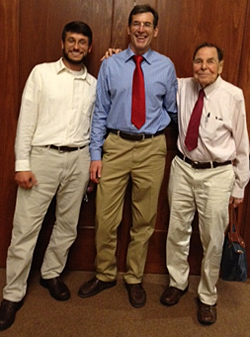Preventive medicine for pipelines

Just days before the 2010 PG&E pipeline disaster in the Bay Area community of San Bruno, residents in the neighborhood reported smelling gas. As it turns out, natural gas was leaking from faulty welds along the pipe that were failing under pressure. The gas line eventually exploded and registered as a small earthquake. The blast killed eight people and destroyed 40 homes. Similar conditions exist elsewhere, and global pipeline failures occur with regularity.
Nationwide, our network of more than 2.5 million miles of pipeline is aging. More than a third of the pipeline infrastructure is over 50 years old, and a reliable method to monitor corrosion hasn’t really existed. Until now.
Jerome Singer, professor emeritus of EECS and engineering science, and two Berkeley Engineering alumni have developed a way to keep tabs on pipeline health by using an MRI machine similar to the ones used in hospitals. Their technology is called the Magnetic Response Imaging System (MRIS), and it will be able to look at the state of underground pipelines.
Comparing the more familiar medical MRI with the pipeline version, Singer says, “Both involve turning on a magnetic field and getting a response signal, which provides an image. For pipelines, we receive a signal that determines the thickness of the pipe material, and we measure that reduction as well as the remaining metal thickness.”

As a professor of radiology at UCSF in the 1970s, Singer pioneered magnetic resonance imaging research that helped advance technology that achieves tissue resolution down to a cubic millimeter. When Singer retired in 2005, he was approached by Glen Stevick (Ph.D.’93 ME), who was updating one of Singer’s earlier MRI machine designs.
After collaborating on that project, Stevick suggested that he and Singer form an engineering firm along with David Rondinone (Ph.D.’02 ME). They started 4D Imaging in Berkeley, specializing in engineering forensics.
“We do structural health management,” says Stevick. “We see so many pipeline failures, but we would rather do a pre-mortem on a pipeline than a post-mortem.”
To obtain an image of a pipeline, 4D’s system relies on a system of copper wire coils that are installed every two meters. A power supply at one end sends pulses of electric current to the coils, which creates a measurable magnetic field. As the pipe starts to fail, the magnetism decreases, indicating that it is time for repair or replacement. The monitoring data can be viewed remotely via a secured website.
“The system can detect metal loss as low as 0.05 percent of the original wall thickness,” says Singer. “Users can set up an alarm system that immediately communicates when metal loss reaches a specified level of concern for the degree of corrosion.”

As the technology and the MRI process develop and become more robust, Stevick says, the system will be able to provide increasingly refined images of pipeline flaws and corrosion.
The team developed prototypes of the tool with a grant from Chevron, and is in talks with both Chevron and Occidental Petroleum about installing MRIS monitors along some of the country’s aging fuel pipelines.
Meanwhile the firm is helping to analyze the 2010 San Bruno pipeline explosion as well as the Deepwater Horizon drilling rig explosion in the Gulf of Mexico.
Their office is easy to recognize; it’s an airy warehouse on Gilman Street in Berkeley with a rusted hunk of the Alaska pipeline resting on top of a storage unit.
